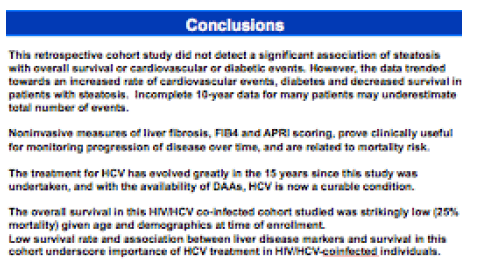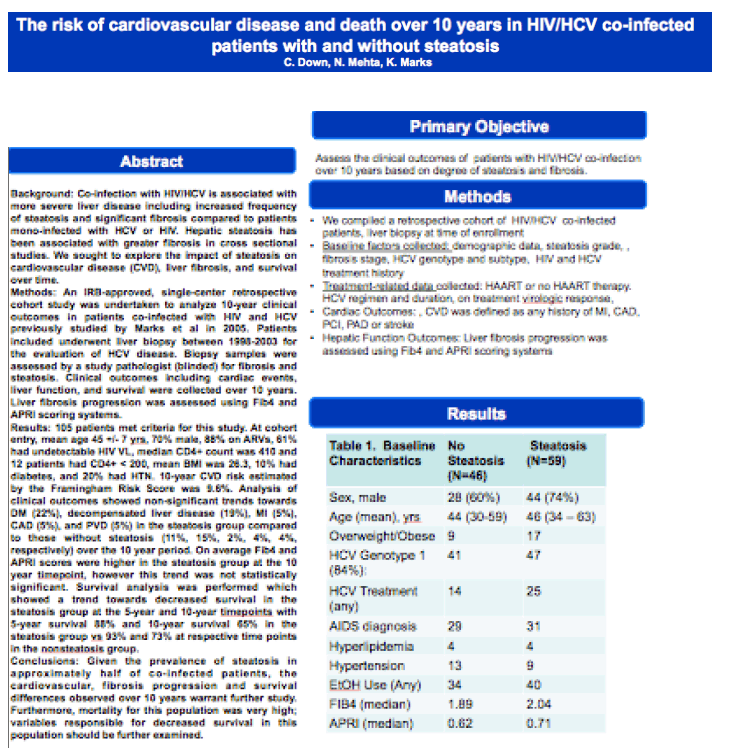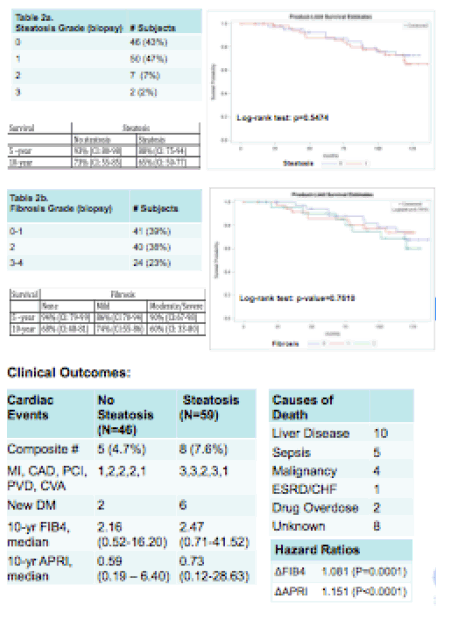 |
 |
 |
| |
More Diabetes and CVD, Shorter Survival, in HIV/HCV-Positives With Steatosis
|
| |
| |
IAS 2015, July 19-22, 2015, Vancouver
Mark Mascolini
HIV/HCV-coinfected people with steatosis had trends toward higher rates of diabetes, decompensated liver disease, and cardiovascular disease (CVD) than coinfected people without steatosis in a 10-year single-center analysis [1]. Weill Cornell researchers characterized survival in the study group as "strikingly low," though again not significantly worse in coinfected people with than without steatosis.
HIV/HCV coinfection has been linked to high rates of steatosis and significant fibrosis, the Weill Cornell team noted, and cross-sectional studies link steatosis with worse fibrosis. They planned this study to gauge the impact of steatosis on cardiovascular disease, other clinical outcomes, and survival over 10 years in HIV/HCV-coinfected people first studied in 2005. All participants had liver biopsy between 1998 and 2003, and a pathologist blinded to patient data evaluated biopsy samples for fibrosis and steatosis. The investigators measured liver fibrosis progression by FIB4 and APRI and tracked liver function, cardiovascular disease, other outcomes, and survival over 10 years.
The analysis involved 59 people with steatosis and 46 without steatosis. Age averaged 46 in the steatosis group and 44 in the no-steatosis group, and 74% and 60% respectively were men. Seventeen people with steatosis (29%) and 9 without steatosis (20%) were overweight or obese. Median FIB4 stood at 2.04 with steatosis and 1.89 without steatosis, and median APRI at 0.71 and 0.62.
Clinical outcome rates were all higher with than without steatosis--diabetes 22% vs 11%, decompensated liver disease 19% vs 15%, MI 5% vs 2%, coronary artery disease 5% vs 4%, and peripheral vascular disease 5% vs 4%--but none of these differences were statistically significant. Five-year and 10-year survival in people with steatosis stood at 88% and 65%, compared with 93% and 73% in the no-steatosis group, but again these differences lacked statistical significance. The researchers noted, though, that incomplete 10-year data for many study participants may have resulted in mortality underestimates.
Change in FIB4 predicted mortality (unadjusted hazard ratio 1.081, P = 0.0001), as did change in APRI (unadjusted hazard ratio 1.151, P < 0.0001). These associations remained highly significant after adjustment for potential confounders such as age, alcohol use, diabetes, and hyperlipidemia. The investigators proposed that these noninvasive measures of fibrosis could prove clinically useful in monitoring liver disease progression over time. Multivariate analysis discerned no impact on survival for risk factors including alcohol use, diabetes, hyperlipidemia, obesity, HIV load, or HCV load.
The Weill-Cornell team concluded that "overall survival in this HIV/HCV-coinfected cohort . . . was strikingly low (25% mortality)," given the age and demographics of these people when they entered the study. They proposed that low survival rates and associations between liver disease markers and survival "underscore the importance of HCV treatment in HIV/HCV-coinfected individuals."
Reference
1. Down C, Mehta N, Marks K. The risk of cardiovascular disease and death over 10 years in HIV/HCV co-infected patients with and without steatosis. IAS 2015. 8th Conference on HIV Pathogenesis, Treatment and Prevention. July 19-22, 2015. Vancouver. Abstract TUPEB246.



|
| |
|
 |
 |
|
|